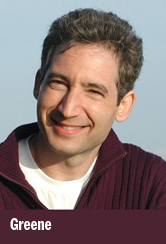The newspaper about public TV and radio
![]()
By Dan Odenwald
Theoretical physicists talk in the language of higher mathematics, which is nearly incomprehensible to outsiders. Not exactly the stuff of compelling TV. But Nova producers hope a visual translation of the terms, along with their fantastic implications, will help lure viewers to this fall's three-hour doc The Elegant Universe.
The two-part series, slated for broadcast Oct. 28 and Nov. 4 [2003], examines the revolutionary concept of string theory, which posits that the universe consists of extraordinarily tiny strings — so small that if an atom were enlarged to the size of our universe, a string would be as big as a tree on Earth.
Depending on how those strings vibrate, they give rise to elementary particles — quarks, electrons and others that scientists once widely accepted as the smallest elements of matter.
Since the 1980s, string theory has riveted scientists because it appears to solve a century-old problem in physics. Until lately, physicists explained the universe in two competing ways: general relativity, which excels at understanding the very large (the planets and stars, for example), and quantum mechanics, which specializes in describing the very small pieces of the subatomic realm. Those theories fall apart when they try to deal with the world beyond their specialties.
String theory — commonly called "the theory of everything" — reconciles the two because it uses a single set of equations to describe how everything, from the largest elements in the universe to the smallest, works according to the same physical principles.
The Elegant Universe is based on the 1999 bestseller of the same name by Columbia University physics professor Brian Greene, who also hosts the doc. Described by Nova Executive Producer Paula Apsell as a "sexy, smart scientist," Greene relies on animation and modeling to reveal how string theory works. By simply showing images without the math, the program shows the "heart of the idea" without confusing or boring viewers, Greene says.
Apsell became aware of Greene as his book climbed the bestseller charts and generated buzz among science journalists. It was later named a Pulitzer finalist and won the Aventis Prize, Britain’s top science book award. Apsell was intrigued by the idea that Green, a string theorist himself, was devoted to sharing his research with the public through popular nonfiction.
She flew to New York to meet with him and was won over by his dynamic
storytelling abilities, which he honed as an actor in college. Explaining
string theory is hard work, Apsell says, but "Greene was enthusiastic
and so were we. It was a marriage made in heaven," she says.
The host's job was made easier by the public's fascination with string
theory. That's not surprising, Greene says. At its core, string theory
seeks answers to life's most basic questions: How was the universe born?
How did we get here? What is space and time? "These are the questions
that have been kicked around for thousands of years," Greene says.
"Now they've entered the realm of science; that's very exciting."
This isn't your father's physics, Apsell says. String theory appeals to the imagination, with incredible consequences such as extra dimensions and parallel universes that seem to come off the pages of science fiction, she says. "You can't get any more exciting that that."
But string theory is plagued by one crucial flaw. While it can be described in mathematical terms, scientists have yet to devise a way to gauge its validity. To some scientists, that makes it irrelevant.
Not so fast, Greene says. Physics has entered an age in which ideas have far outpaced the experimental capacity of even the most cutting-edge equipment. String theory is difficult to dismiss because it wasn't pulled out of thin air, Greene adds, but arose out of the well-proven laws of general relativity and quantum mechanics.
Nova producers thought long and hard about devoting three hours to a scientific theory that isn't yet testable, Apsell says. They got advice from numerous physicists.. Even the skeptics, who are featured throughout the doc, agree there's a lot of "heft to this subject," she says.
Above all, Greene hopes the doc will familiarize viewers with the progress that's been made in modern science in the last few decades. "Science is an integral part of human society and thought," he says, and it's a huge problem that modern physics is being developed in language that few people speak. "It's our obligation to phrase it in a way that everybody can understand," he says.
The animation that makes that possible contributed greatly to the $3 million cost of The Elegant Universe. Nova really put itself out there to raise the money for this show, Apsell says. "We very seldom get to tell stories like this," she adds.
PBS plans a heavy publicity campaign for the show this fall and recently touted it at last week's TV press tour in Hollywood. Major funding came through the Alfred P. Sloan Foundation, the National Science Foundation and the Department of Energy.

EARLIER ARTICLES
Its executive producer, Paula Apsell, describes Nova's approach.
OUTSIDE LINKS
Nova's website for the series.
The Official String Theory Web Site and its page about Greene.
WGBH sells Greene's book, $15 in paperback.
![]()
Web page posted July
14, 2003
Current
The newspaper about public television and radio
in the United States
A service of Current Publishing Committee, Takoma Park, Md.
E-mail: web![]() current.org
current.org
301-270-7240
Copyright 2003
